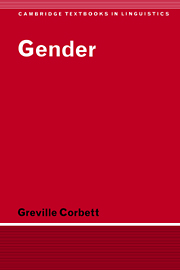Book contents
- Frontmatter
- Contents
- List of figures
- List of tables
- Preface
- List of abbreviations
- 1 INTRODUCTION
- 2 GENDER ASSIGNMENT I: SEMANTIC SYSTEMS
- 3 GENDER ASSIGNMENT II: FORMAL SYSTEMS
- 4 THE PSYCHOLINGUISTIC STATUS OF GENDER ASSIGNMENT
- 5 GENDER AGREEMENT
- 6 ESTABLISHING THE NUMBER OF GENDERS
- 7 TARGET GENDERS: SYNCRETISM AND ENFORCED GENDER FORMS
- 8 HYBRID NOUNS AND THE AGREEMENT HIERARCHY
- 9 GENDER RESOLUTION RULES
- 10 GENERALIZATIONS AND PROSPECTS
- References
- Author index
- Language index
- Subject index
9 - GENDER RESOLUTION RULES
Published online by Cambridge University Press: 05 June 2012
- Frontmatter
- Contents
- List of figures
- List of tables
- Preface
- List of abbreviations
- 1 INTRODUCTION
- 2 GENDER ASSIGNMENT I: SEMANTIC SYSTEMS
- 3 GENDER ASSIGNMENT II: FORMAL SYSTEMS
- 4 THE PSYCHOLINGUISTIC STATUS OF GENDER ASSIGNMENT
- 5 GENDER AGREEMENT
- 6 ESTABLISHING THE NUMBER OF GENDERS
- 7 TARGET GENDERS: SYNCRETISM AND ENFORCED GENDER FORMS
- 8 HYBRID NOUNS AND THE AGREEMENT HIERARCHY
- 9 GENDER RESOLUTION RULES
- 10 GENERALIZATIONS AND PROSPECTS
- References
- Author index
- Language index
- Subject index
Summary
Gender resolution is an area in which the data are often surprising and interesting, yet the topic is frequently left out of account. The term ‘resolution rule’ is taken from Givón (1970), and it refers to a rule which specifies the form of an agreeing element (or target) when the controller consists of conjoined noun phrases. If we have a sentence like Mary and John are happy, it is the number resolution rule which specifies the use of the plural are, rather than is. If we translate this sentence into a language like French, where predicative adjectives agree in gender, we need a gender resolution rule to establish the gender of the adjective, since one conjunct is feminine and the other is masculine. We shall also meet more complex cases: in Slovene, if a neuter singular and a feminine singular are conjoined, it is the gender and number resolution rules which specify the form of the target, say the verbal predicate, as masculine dual. This example, like the English one, illustrates the point that resolution rules do not operate only to resolve feature clashes but can also operate when conjuncts share features (singular in this example). It also suggests that this topic draws together problems connected with controller genders and target genders. While gender resolution will be our main concern, we should see it in the wider context of feature resolution (section 9.1).
- Type
- Chapter
- Information
- Gender , pp. 261 - 306Publisher: Cambridge University PressPrint publication year: 1991



